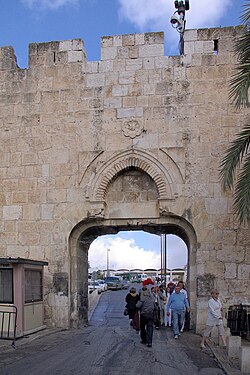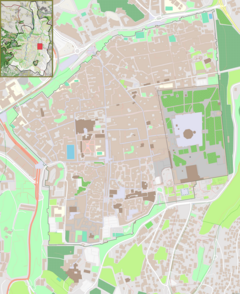| Revision as of 04:09, 23 June 2017 editمحمد معاذ الكلياني (talk | contribs)2 edits باب المغاربة the traslation of this word in english is moroccan gate build for the honor of moroccan people who helped palestine to take AlqudsTags: Mobile edit Mobile web edit← Previous edit | Revision as of 04:15, 23 June 2017 edit undoHertz1888 (talk | contribs)Extended confirmed users, Pending changes reviewers, Rollbackers57,227 editsm Reverted 1 edit by محمد معاذ الكلياني (talk): Rv per WP:COMMONNAME. Also must match title of article. (TW)Next edit → | ||
| Line 1: | Line 1: | ||
| {{Infobox building | {{Infobox building | ||
| | name = |
| name =Dung Gate | ||
| | native_name = | | native_name = | ||
| | native_name_lang = | | native_name_lang = | ||
| Line 64: | Line 64: | ||
| ] | ] | ||
| The ''' |
The '''Dung Gate''' (''also known as, {{lang-he|שער האשפות}} Sha'ar Ha'ashpot, Gate of Silwan, Moroccan Gate'', {{lang-ar|باب المغاربة}}) is one of the gates in the walls of the ]. It was built in the 16th century. | ||
| The gate is situated near the southeast corner of the old city, southwest of the ]. | The gate is situated near the southeast corner of the old city, southwest of the ]. | ||
| The gate is the closest to the ] and is a main passage for vehicles coming out of the Old City and for buses headed to the ]. It was originally much smaller, but was enlarged in 1952, after the Old City came under ]ian control in 1948. After its capture by Israel in 1967, architect Shlomo Aronson was commissioned to renovate this gate.<ref>{{cite web|url=http://www.s-aronson.co.il/Selected-Projects-List.html |title=Landscape Selected Projects List by Shlomo Aronson |author=Shlomo Aronson |accessdate=2008-06-13 |archiveurl=https://web.archive.org/web/20080427225855/http://s-aronson.co.il/Selected-Projects-List.html |archivedate=2008-04-27 |deadurl=yes |df= }}</ref> Directly behind the gate lies the entrance to the ] compound. | The gate is the closest to the ] and is a main passage for vehicles coming out of the Old City and for buses headed to the ]. It was originally much smaller, but was enlarged in 1952, after the Old City came under ]ian control in 1948. After its capture by Israel in 1967, architect Shlomo Aronson was commissioned to renovate this gate.<ref>{{cite web|url=http://www.s-aronson.co.il/Selected-Projects-List.html |title=Landscape Selected Projects List by Shlomo Aronson |author=Shlomo Aronson |accessdate=2008-06-13 |archiveurl=https://web.archive.org/web/20080427225855/http://s-aronson.co.il/Selected-Projects-List.html |archivedate=2008-04-27 |deadurl=yes |df= }}</ref> Directly behind the gate lies the entrance to the ] compound. | ||
| ==Name== | ==Name== | ||
Revision as of 04:15, 23 June 2017
| Dung Gate | |
|---|---|
 Dung Gate Dung Gate | |
 | |
| General information | |
| Town or city | Jerusalem |
| Coordinates | 31°46′29″N 35°14′2″E / 31.77472°N 35.23389°E / 31.77472; 35.23389 |

The Dung Gate (also known as, Template:Lang-he Sha'ar Ha'ashpot, Gate of Silwan, Moroccan Gate, Template:Lang-ar) is one of the gates in the walls of the Old City of Jerusalem. It was built in the 16th century.
The gate is situated near the southeast corner of the old city, southwest of the Temple Mount.
The gate is the closest to the Western Wall and is a main passage for vehicles coming out of the Old City and for buses headed to the Western Wall. It was originally much smaller, but was enlarged in 1952, after the Old City came under Jordanian control in 1948. After its capture by Israel in 1967, architect Shlomo Aronson was commissioned to renovate this gate. Directly behind the gate lies the entrance to the Western Wall compound.
Name
The name Sha'ar Ha'ashpot appears in the Book of Nehemiah 2:13-14. It is probably named after the residue that was taken from the Jewish Temple into the Valley of Hinnom, where it was burned. This ancient "Dung Gate" may not have been in the same location as the modern gate.
The name Moroccan gate (Bab al-Magharibeh) refers to the Moroccan Quarter, which was situated near the area until 1967.
The name Silwan Gate refers to the village of Silwan that lies just south of the gate.
References
- Shlomo Aronson. "Landscape Selected Projects List by Shlomo Aronson". Archived from the original on 2008-04-27. Retrieved 2008-06-13.
{{cite web}}: Unknown parameter|deadurl=ignored (|url-status=suggested) (help)
External links
31°46′29″N 35°14′2″E / 31.77472°N 35.23389°E / 31.77472; 35.23389
This Israel-related article is a stub. You can help Misplaced Pages by expanding it. |
This geography of Israel article is a stub. You can help Misplaced Pages by expanding it. |
